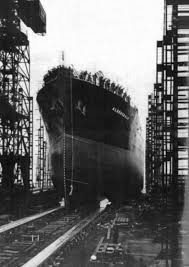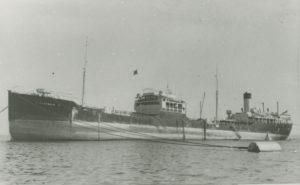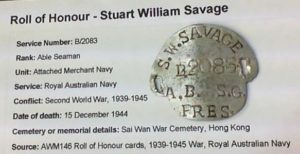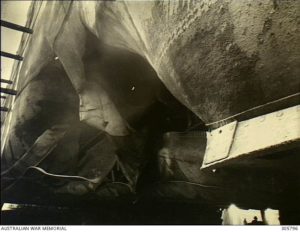- Author
- Swinden, Greg
- Subjects
- Ship histories and stories, WWII operations, History - WW2
- Tags
-
- RAN Ships
- None noted.
- Publication
- September 2020 edition of the Naval Historical Review (all rights reserved)
By Greg Swinden
RFA Bishopdale was a Royal Fleet Auxiliary Dale class freighting tanker that saw service during the period 1939-1959. As a freighting tanker her main role was to move large quantities of fuel (up to 11,600 tons of mainly furnace fuel oil) from oil refineries to Royal Navy fuel depots. During 1942-45 she served on loan to the Royal Australian Navy (RAN) with a mixed crew of RAN and Merchant Navy personnel.
She was built by Lithgows Ltd of Glasgow and launched on 31 March 1937. After completing sea trials, in June 1937 she conducted her first delivery voyage in July of that year; a run from the West Indies to Gibraltar. Further freighting voyages were conducted during the next two years which involved taking on bulk fuel at the Anglo-Persian Oil Company refinery at Abadan, Persia and delivering the cargo to Royal Navy fuel depots in Gibraltar, Port Said and Singapore. Her crew throughout most of her service were British officers and British Indian ratings.

Following the outbreak of war in September 1939 Bishopdale was allocated to the West Indies Station as a tanker for RN ships operating in that area; keeping watch on German merchant ships in neutral ports, particularly in the United States of America. It was here that the tanker had her first contact with the RAN when she refueled the light cruiser HMAS Perth at Kingston on 2 January 1940. Perth was on loan to the Royal Navy during September 1939 – February 1940 and her ship’s company also took the opportunity to practise their boarding party drills onboard Bishopdale while the cruiser was refueled. The tanker remained on the West Indies station conducting the routine but essential fueling of warships until early January 1942.

In mid-January 1942 Bishopdale was ordered to sail via the Panama Canal to the Pacific and refuel the battleship HMS Warspite in the vicinity of Henderson Island (part of the Pitcairn Island Group). Warspite was transiting from Vancouver to Sydney on her way to join the British Eastern Fleet in Ceylon. Bishopdale arrived in Sydney on 6 April 1942 and was subsequently lent to the RAN for service in the Pacific. She maintained her Merchant Navy ship’s company but RAN personnel, DEMS (Defensively Equipped Merchant Ship) gunners were placed onboard to operate the ship’s weapons, consisting of a 4-inch gun on her quarterdeck, a 12 pounder gun forward and several Oerlikon 20 mm anti-aircraft guns. When not conducting their naval duties the DEMS gunners were employed as deckhands, and this included duties such as lookouts, handling lines when ships came alongside to refuel, upper deck maintenance such as chipping rust and painting and also operating the ship’s motor boats.
During April – August 1942 Bishopdale was based at Noumea, New Caledonia refueling RAN and US Navy warships operating in the South-West Pacific including HMA Ships Canberra and Hobart on their way to the Allied landings at Guadalcanal in the Solomon Islands. On 5 August 1942 Bishopdale sailed from Noumea, proceeding to Brisbane to replenish her bunkers. While transiting the Havannah-Boulari passage, east of Noumea, she strayed off course and struck an Allied mine in a defensive minefield protecting the passage. Fortunately there were no casualties but the tanker wasforced to return to Noumea. Temporary repairs were made allowing Bishopdale to sail to Sydney for docking with the subsequent repairs taking several months to complete.
When repairs were completed in January 1943 Bishopdale returned to her unsung duties of providing fuel to the RAN. She departed Sydney on 3 February 1943, as part of a convoy heading north, and berthed in Darwin in mid-February to replenish the fuel storage depot in that port.

After completing this task she returned to Queensland waters in March via Port Moresby where the fuel depot ashore was replenished.
The period March to late June 1943 was spent providing fuel to RAN and US Navy ships in Queensland waters prior to operating at Milne Bay, New Guinea from July 1943 until March 1944, again refueling Allied warships. The only interruption to this was the occasional return to Queensland ports to replenish her fuel bunkers. On 11 November 1943, while part of a convoy in Queensland waters, she collided with the aircraft carrier USS Bunker Hill and suffered some damage to her stern and starboard Oerlikon gun mountings. The US warship incurred minor scrapes and scratches to her paintwork.
In early March 1944 Bishopdale steamed south to Sydney for maintenance and after completing this headed north again but this time to Humboldt Bay (Dutch New Guinea) which in late April became her new forward refueling location. This was her new ‘home’ for the next eight months providing the essential ‘black gold’ to keep the RAN and US Navy warships in the fight as Japanese forces were driven out of New Guinea and preparations were made for the liberation of the Philippines. Rather than return Bishopdale to Australian waters to refuel, her bunkers were replenished by larger civilian tankers.
In mid-November 1944 Bishopdale departed Humboldt Bay as part of Task Group 77.7 supporting the Allied landings at Leyte Gulf in the Philippines. Again, her task was to supply fuel and lubricating oil to Allied warships and she arrived at San Pedro Bay in late November. The landings at Leyte Gulf were hotly contested by Japanese naval and air forces with the first of the kamikaze attacks beginning with aircraft deliberately being flown by their pilots into Allied ships.
On 14 December 1944 Bishopdale was in San Pedro Bay when she was struck by a Japanese ‘Val’ dive bomber. The kamikaze aircraft hit the ship’s forward mast, then crashed into the starboard upper bridge and the No.3 wing tank where it exploded. Bishopdale suffered significant damage and over the next few days three of her ship’s company died of wounds. They were 26-year old Able Seaman Stuart Savage (one of the ship’s Australian DEMS gunners), Indian Pumpman Umar Abdullah (Omer Abdoola) who died on 15 December 1945 and Pumpman Coner A. Sheik who died on 16 December.

Despite the damage and casualties the tanker remained at San Pedro Bay providing fuel to Allied ships until the end of the month. On 30 December 1944 she sailed for Hollandia (now Jayapura) in Dutch New Guinea for repairs which tookseveral months. Able Seaman Savage and Pumpman Sheik were originally buried in the US Military Cemetery at Leyte Gulf; but they were later reinterred at the Commonwealth War Graves Commission cemetery at Sai Wan Bay in Hong Kong. Pumpman Abdullah (Abdoola) was buried at sea and his name recorded on the Bombay/Chittagong 1939-1945 War Memorial.
The ship’s Master, Commander Murray William Westlake, RNR was subsequently awarded a Distinguished Service Cross (DSC) and three other crew members (Chief Officer W.E. Tate, First Pumpman Sheikh Allen St. Hassan and Second Pumpman Omar Abdoola) were Mentioned in Dispatches. The awards were announced in the London Gazette on 18 December 1945 with the citation for all four men reading: For courage, efficiency and skill in damage control when a Japanese aircraft struck the RFA Bishopdale, in San Pedro Bay, Leyte Gulf on 14th December 1944. Two compartments were flooded, fire broke out and the ship took a list. By prompt action she was brought back to an even keel and ready to continue fueling within half-an-hour of the attack.
Bishopdale returned to operational duties in mid-May 1945 and arrived at the island of Morotai (Netherlands East Indies) later that month. Allied forces had landed on Morotai in September 1944 and soon had an air base operating for strikes on the Philippines and Borneo. Japanese forces were still present on the island and, while isolated, did not surrender until September 1945. The tanker remained at Morotai until late September 1945.
Following the end of World War II Bishopdale returned to Royal Navy service and proceeded via Subic Bay (The Philippines) to Hong Kong. Her last known fueling of an RAN vessel was the corvette HMAS Ballarat, at Hong Kong on 15 November 1945. She then operated far and wide delivering fuel from Abadan to Hong Kong and Singapore during 1946.
She occasionally visited Australia, delivering a cargo of fuel to the Chowder Bay Naval Fuel Installation (Sydney) in September 1948 and to Melbourne in November 1949, but Bishopdale mainly operated in the Indian Ocean, Mediterranean, Atlantic Ocean and West Indies for the remainder of her career. Bishopdale was laid up in Reserve (at Devonport, England) on 8 October 1959 and in mid-January 1970 was sold for scrap. She arrived at Bilbao, Spain on 17 February 1970 for breaking up.
RFA Bishopdale – Main Characteristics
Displacement: 17,357 tons. Gross 8,406 tons
Length: 146.8 metres. Beam 18.8 metres. Draught 8.4 metres
Speed: 11.5 knots (maximum) 10 knots economical cruising
Complement: 14 officers, 31 ratings plus weapons crews
Weapons (Leyte Gulf): 4-inch gun, 12 pounder guns, multiple 20 mm Oerlikon anti-aircraft guns
Machinery: Doxford Diesel engines developing 4,000 Brake Horse Power on a single shaft.




